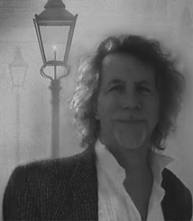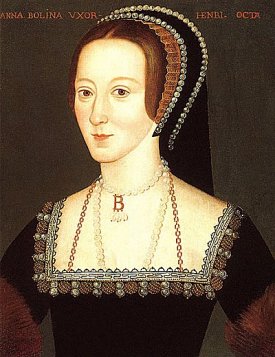Hey everyone! Please welcome Robert Parry, author of The Arrow Chest, to ATHF! Read my 4 1/2 star review of this book and don't forget to sign up for a chance to win a copy of The Arrow Chest. Click here to read and sign up!
Thank you Taylor for the opportunity to tell your readers about my new novel, ‘The Arrow Chest.’
When we look back to the year 1536 and to the execution of Henry VIII’s second wife, Anne Boleyn, we are faced with one of the most bizarre and puzzling questions of English history. Why, after her death was her body (and head) placed in an old arrow chest and buried, unmarked, beneath the floor of the Chapel in of the Tower of London? How strange! That a Queen of England should be treated with such disrespect. Hardly a dignified burial!
An arrow chest in Tudor times was a large wooden box for storing arrows, but also for housing long-bow staves - sufficient in size, therefore, to be able to take a body. It was made of elm wood and might have been decorated or inlayed in some way according to the status of its owner.
Being learned and educated in the classics was important in Tudor times. Henry certainly liked to think of himself as a ‘Renaissance man’ in this respect, fluent in Greek and Roman mythology. He liked to identify himself with the archer-god Apollo, master of poetry and music, sports and games - an ideal allegorical figure for the still-young and athletic king of England at the time of his marriage to Anne Boleyn. During Anne’s coronation there was even a special tableau designed by the great artist of the Tudor court, Hans Holbein, located on the procession route and in which Henry was depicted as the god Apollo seated on a throne surrounded by the Muses.
 Which brings me to my story. Without giving too much away, it is a kind of Tudor love triangle, only moved forward in time to the 19th century and to the gloriously extravagant neo-Gothic culture of Victorian England. This time shift is perhaps not so odd as it might at first seem. The Victorian age had many parallels to that of the Tudors. There were plenty of powerful men at large – ‘kings’ in their own right. There were beautiful elegant women, and there were the fabulous poets and painters of the Pre-Raphaelite movement. So it was not difficult to find surrogates for Anne, Henry and for Thomas Wyatt in that kind of environment. The Victorians in the 19th century, moreover, had to endure their very own crises in faith, similar to the experience of the 16th century Reformation, with the arrival of Darwin’s theory of evolution and the threat this held for the established Church at the time.
Which brings me to my story. Without giving too much away, it is a kind of Tudor love triangle, only moved forward in time to the 19th century and to the gloriously extravagant neo-Gothic culture of Victorian England. This time shift is perhaps not so odd as it might at first seem. The Victorian age had many parallels to that of the Tudors. There were plenty of powerful men at large – ‘kings’ in their own right. There were beautiful elegant women, and there were the fabulous poets and painters of the Pre-Raphaelite movement. So it was not difficult to find surrogates for Anne, Henry and for Thomas Wyatt in that kind of environment. The Victorians in the 19th century, moreover, had to endure their very own crises in faith, similar to the experience of the 16th century Reformation, with the arrival of Darwin’s theory of evolution and the threat this held for the established Church at the time.
Thank you Taylor for the opportunity to tell your readers about my new novel, ‘The Arrow Chest.’
When we look back to the year 1536 and to the execution of Henry VIII’s second wife, Anne Boleyn, we are faced with one of the most bizarre and puzzling questions of English history. Why, after her death was her body (and head) placed in an old arrow chest and buried, unmarked, beneath the floor of the Chapel in of the Tower of London? How strange! That a Queen of England should be treated with such disrespect. Hardly a dignified burial!
An arrow chest in Tudor times was a large wooden box for storing arrows, but also for housing long-bow staves - sufficient in size, therefore, to be able to take a body. It was made of elm wood and might have been decorated or inlayed in some way according to the status of its owner.
Arrows were significant to the Tudors not only as weaponry, but because they were also used for the hunting of deer and wild boar - a pastime reserved for the aristocracy at the time - and the symbolism of the hunt and the ‘chase’ often became associated with courtly romance and sexual desire. Henry, for example, in one of his love-letters to Anne Boleyn mentions being struck by Cupid’s dart! Cupid is not just the chubby little rascal with the bow that we find on Valentine cards – he was regarded as an important classical figure, wound up in the myth of Daphne and Apollo, and we find him mentioned frequently in the poetry of Sir Thomas Wyatt – a handsome, gifted man whom Henry always perceived (rightly or wrongly, we shall never know) as a rival for Anne Boleyn’s affections.
Being learned and educated in the classics was important in Tudor times. Henry certainly liked to think of himself as a ‘Renaissance man’ in this respect, fluent in Greek and Roman mythology. He liked to identify himself with the archer-god Apollo, master of poetry and music, sports and games - an ideal allegorical figure for the still-young and athletic king of England at the time of his marriage to Anne Boleyn. During Anne’s coronation there was even a special tableau designed by the great artist of the Tudor court, Hans Holbein, located on the procession route and in which Henry was depicted as the god Apollo seated on a throne surrounded by the Muses.
 Which brings me to my story. Without giving too much away, it is a kind of Tudor love triangle, only moved forward in time to the 19th century and to the gloriously extravagant neo-Gothic culture of Victorian England. This time shift is perhaps not so odd as it might at first seem. The Victorian age had many parallels to that of the Tudors. There were plenty of powerful men at large – ‘kings’ in their own right. There were beautiful elegant women, and there were the fabulous poets and painters of the Pre-Raphaelite movement. So it was not difficult to find surrogates for Anne, Henry and for Thomas Wyatt in that kind of environment. The Victorians in the 19th century, moreover, had to endure their very own crises in faith, similar to the experience of the 16th century Reformation, with the arrival of Darwin’s theory of evolution and the threat this held for the established Church at the time.
Which brings me to my story. Without giving too much away, it is a kind of Tudor love triangle, only moved forward in time to the 19th century and to the gloriously extravagant neo-Gothic culture of Victorian England. This time shift is perhaps not so odd as it might at first seem. The Victorian age had many parallels to that of the Tudors. There were plenty of powerful men at large – ‘kings’ in their own right. There were beautiful elegant women, and there were the fabulous poets and painters of the Pre-Raphaelite movement. So it was not difficult to find surrogates for Anne, Henry and for Thomas Wyatt in that kind of environment. The Victorians in the 19th century, moreover, had to endure their very own crises in faith, similar to the experience of the 16th century Reformation, with the arrival of Darwin’s theory of evolution and the threat this held for the established Church at the time.So there you have it! The story opens in 1876, the year in which the skeletal remains of Anne Boleyn first came to light during a renovation project in the Chapel of St Peters ad Vincula at the Tower of London. It is a Tudor story - only moved forward a few centuries to become a gothic tale of mystery and intrigue.
Thank you Robert for taking the time to stop by and talk with us today! If this sounds like a book you would enjoy reading click here to sign up for the chance to win a copy! Giveaway open to US & Canada residents only and end
Feb. 10th.



I didn't know that about Cupid. I always do think of Valentine's Day, when I think of him. It is cool to see him in a different way.
ReplyDeleteI am looking forward to reading the book!
For those who do not win a copy here, there will be more chances coming up. See the upcoming tour dates starting in mid February, here: http://www.virtualauthorbooktours.com/2011/01/robert-parry-author-of-arrow-chest-is.html
I know I thought Roberts post was really interesting. I can't believe they buried Anne Boleyn in a box meant to store arrows. They didn't even think she deserved a proper casket and she was buried under the chapel and forgotten.
ReplyDeleteTaylor~